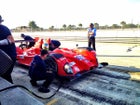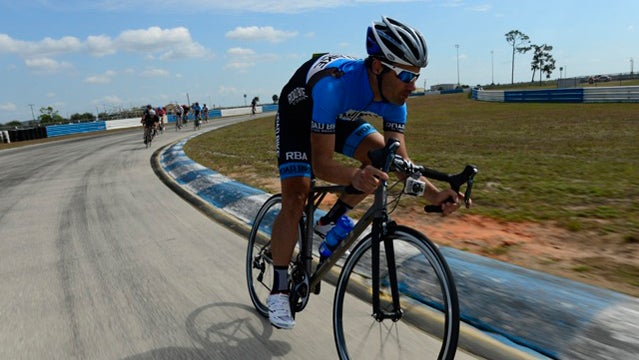Central Florida, I recently discovered, is where the road bike rubber meets the road. It was last week at least, as used the locale to roll out two new high-end road tires that have been in development for several years. And while Florida might seem an odd venue for a cycling event, Michelin chose it because of the company’s affiliation with and testing partnerships at the . The idea was to not only to launch the tires in a venue that would show off their capabilities but to also place Michelin’s bike division in the context of the broader company, especially its pioneering motorsports division.
 Sebring International Raceway.
Sebring International Raceway. New tires.
New tires.Michelin debuted the Pro 4 Comp ($80) and the Pro 4 Grip ($75). The launch presentation was stuffed with stats and technical talk: the Comp is 7 percent more efficient than the current Pro 4 Service Course; the 150 TPI casing on the Comp is lighter and more supple than the 110 TPI casing on the Service; the Grip offers 15 percent better traction in wet conditions than either tire. But the backdrop of Sebring provided the most interesting message.
Out on the track, we watched Vipers and Porsches and Formula 1 racecars roar through corners and blast in and out of the pits. The lap record at Sebring is 1 minute, 43 seconds, and racers take the tightest hairpin on the course at 60 to 70 miles per hour. Watching cars going so hard through turns that they look like they might come unglued, it was clear just how critical rubber can be. According to Bob Williams, Motorsports Program Manager for Michelin, the company sponsors motorsports racing largely for research sake. “Our engineers work directly with our racers,” Williams said. “It’s an important piece of our product development.” Michelin prides itself on its engineering. It pours nearly $1 billion annually into research and development, and at its headquarters in Ladoux, France, there’s a private F1 course as well as a dedicated wet track with a technician who is paid to keep the depth of the water on the track consistent for accurate testing.
It’s true that much of the money and research goes to the vaunted motorsports projects, but all divisions have company-wide access to rubber compounds and other research. “There are weekly sit-downs between divisions,” says Nick Margadonna, sales and marketing manager for the North American division of Michelin bikes. “It’s a collaborative environment, and our bike tires benefit from the company’s full know-how and technology.” Development of the new Pro 4 Comp took over 50 machines, 100 hours of computer development, and 150,000 miles of real-world testing. Those numbers sound impressive. But what really hits home is seeing racecars rip along at 200 miles per hour and knowing that the technology that keeps them glued to the track benefits the tires that keep bicycles on the road on high-speed mountain descents.
We did our own trials on the 3.7-mile racetrack at Sebring, which is best known for hosting the . Michelin had the track shut down to cars for an hour during our visits, and under the curious and disbelieving eyes of the racecar teams, 10 journalists logged a handful of laps on the new tires, complete with a pit stop to change between the models. Sebring is a repurposed army base, and the surface on the racetrack, constructed of 20-foot-deep blocks of concrete so B-52s could land here, is rough and pocked with seams. On this variable surface, the Pro 4 Comps felt supple, compliant, and secure in the corners, and the lightweight of the tire was noticeably quick to spin up. We rode the Pro 4 Grips, too, though without a technician to wet the track, we didn’t get much sense of their performance. Tires aside, it’s certain that our sub-9-minute laps were easily the slowest times ever logged at Sebring.
In the pits, Jens Walther, president of Porsche Motorsports USA, which uses Michelins, took a few minutes to talk to us about their program, and we exclaimed at the array of stunning cars the team had on the track. Surprisingly, Walther seemed genuinely interested in our endeavor, too. “I was really impressed to see you guys all out there, racing around on your bikes,” he said.
“Credit the tires,” someone yelled out.


